|
Report from
Europe
Imports of tropical wood rebound in the UK but lose
share in a rising market
The UK imported tropical wood and wood furniture
products with a total value of USD760 million in the first
seven months of 2021, a 36% increase compared to the
same period in 2020.
Following the sharp increase in April, when import value
was at the highest monthly level since before the financial
crises of 2008-2009, imports declined only slightly from
this peak between May and July (Chart 1).
While UK import value of tropical and wood furniture was
strong compared to the first seven months last year, which
was severely affected by COVID lockdowns, import value
was marginally down compared to USD762 million in the
same period of 2019.
This is disappointing at a time when import prices are
inflated by a dramatic rise in freight rates, particularly
from Southeast Asia and other tropical supply regions, and
overall demand for timber products in the UK is at
unprecedented levels.
This year, the UK is experiencing a very robust rise in
construction sector activity and in timber trade and
consumption. There has been a welcome rebound from the
lows of last year in the value of wood product imports
from tropical countries into the UK, and importers are
benefiting from strong sales, high prices and larger
margins. However, much bigger gains are being made in
this market by wood products suppliers outside the tropics.
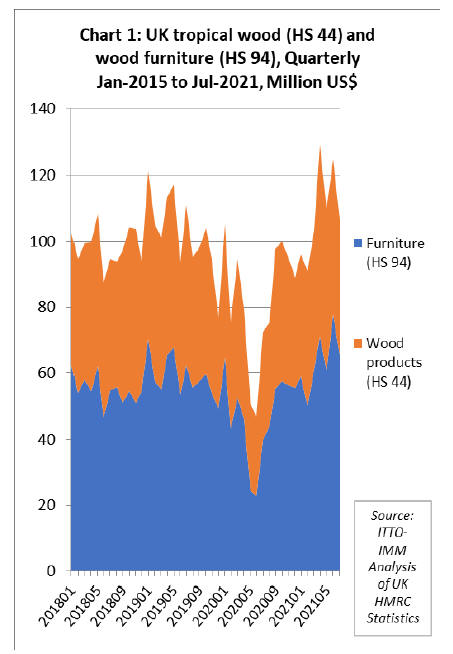
The latest UK Construction Products Association (CPA)
Trade Survey shows construction remained in expansion
mode during the second quarter of this year, with private
housing and repairs, maintenance and improvement
leading the industry. Much of the activity in these sectors
has been sustained by government housing policies, an
increase in the disposable income across households in the
UK, and a homeworking trend that has been driving
demand for greater or improved outdoor and office space.
According to the Building Merchants Building Index
(BMBI), in the three months between May and July this
year, UK sales of timber were at record levels and
performing better than all other building material
categories. During the three month period, total UK
builders' merchant sales were 35% up on a COVIDaffected
period last year, while sales of timber and joinery
products increased 65%. Total sales in May to July were
9% higher than in February to April, while timber and
joinery products sales were up 19%.
Sales were also exceptionally strong compared to 2019,
before the pandemic. Total builder's merchant sales in
May to July 2021 were 17% higher than in May to July
2019, while timber and joinery product sales were 44%
higher.
A statement by the UK Timber Trade Federation issued
earlier in September suggests that longer term prospects
for timber demand in the UK are good, but short term
logistical issues are putting severe strain on supply.
¡°The supply chain has been working hard to satisfy this
additional demand, which is expected to continue in the
short to medium term according to industry forecasts.
While some of this demand may ease as pandemic
restrictions subside, the demand for timber is likely to
remain strong amidst a construction industry seeking to
rapidly decarbonise.
By choosing to build with responsibly sourced timber,
architects, engineers and house builders are helping to turn
our built environment into a form of carbon capture and
storage. There is a significant opportunity for the timber
sector to grow into a pillar of the UK¡¯s low-carbon
economy".
The TTF go on to note that ¡°The main brake on this
growth will come from other factors, particularly labour
shortages in areas across the supply chain from logistics to
skilled on-site labour, with the CBI [Confederation of
British Industry] warning this could take at least two years
to settle down.¡±
The latest IHS Markit/CIPS UK Construction Purchase
Managers Index (PMI) for August suggests that these
factors are beginning to act as a drag on the rate of market
growth. The PMI dropped to 55.2 in August 2021, from
58.7 in the previous month and below market expectations
of 56.9. Although any figure over 50 indicates continuing
growth in the UK construction sector, the latest reading
points to the softest pace of expansion since February.
Commenting on the slowing growth in August, IHS
Markit/CIPS note that "given the amount of stimulus and
relatively early stage in the recovery, to be slowing so
close to the long-term trend is disappointing. Part of the
slowdown can be linked to weaker growth of new orders
for construction work, with the survey's New Orders Index
slowing for a third consecutive month to register a further
cooling of demand growth from May's record high.
"The slowdown can also be partly attributed to ongoing
and near-record shortages of raw materials, as measured
by suppliers' delivery times, which have in turn led to
unprecedented price hikes for building materials in recent
months¡ in August 68% of construction companies
reported even longer delivery times for materials
compared to July. A combination of ongoing covid
restrictions, Brexit delays and shipping hold-ups were
responsible as builders were unable to complete some of
the pipelines of work knocking on their door".
However, IHS Markit/CIPS end on a positive note,
¡°optimism improved on last month as more than half of
building firms believe that output will continue to rise in
the year ahead.¡±
UK tropical furniture imports recover ground lost
during the pandemic
Overall the UK imported USD445 million of tropical
wood furniture products in the first seven months of this
year, 52% more than the same period in 2020, but just 3%
more than the same period in 2019. After a slow first
quarter this year, when lockdowns once again disrupted
trade, imports strengthened considerably in the second
quarter to reach monthly highs not seen for over a decade.
Overall during the first seven months of 2021 compared to
the same period last year, UK wood furniture imports were
up from all four of the leading tropical supply countries to
this market; Vietnam (+41% to USD214 million),
Malaysia (+44% to USD88 million), Singapore (+123% to
USD43 million), India (+103% to USD41 million),
Indonesia (+50% to USD40 million) and Thailand (+19%
to USD10 million).
While gains were made across the board when compared
to the depressed levels of 2020, wood furniture import
value was still trailing the pre-pandemic 2019 level from
Vietnam (-6%), Malaysia (-6%), Indonesia (-1%), and
Thailand (-15%).
In contrast the pre-pandemic rise from India has resumed,
with import value from the country 30% higher this year
than in 2019. Import value from Singapore, which has
become more important as a supply hub due to logistical
problems elsewhere during the pandemic, is 130% higher
than in 2019 (Chart 2).
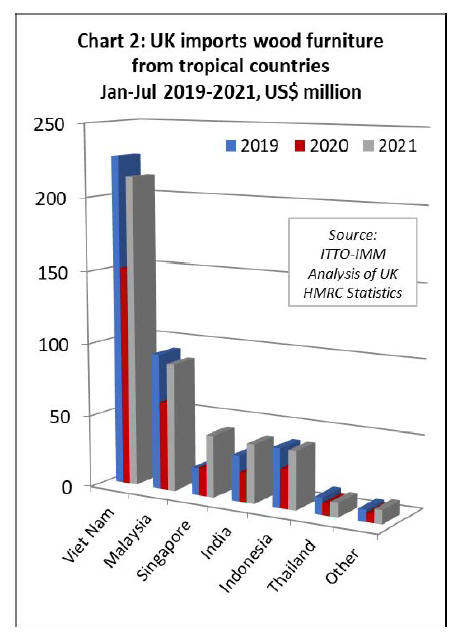
UK tropical wood imports still down on pre-pandemic
level
UK import value of all tropical wood products in Chapter
44 of the Harmonised System (HS) of product codes was
USD315 million in the first seven months of 2021, 36%
more than the same period last year but 5% less than the
same period in 2019.
Comparing UK import value in the first seven months of
2021 with the same period in 2020, tropical joinery was up
57% at USD132 million, tropical plywood was up 29% at
USD94 million, tropical sawnwood was up 12% at USD46
million, and tropical mouldings/decking was up 47% at
USD8 million.
While import value of tropical joinery in the first seven
months of this year was also up 34% on pre-pandemic
level in 2019, UK import value of all other HS 44 tropical
wood products was significantly behind the 2019 level
including plywood (-24%), sawnwood (-25%), and
mouldings/decking (-17%) (Chart 3).
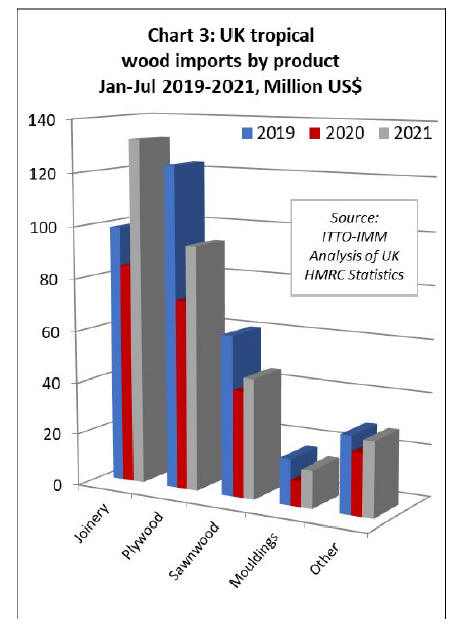
After the sharp dip in UK imports of tropical joinery
products during the first lockdown period in Q2 2020,
imports gradually built momentum until March this year
and then surged in the second quarter. Imports from
Indonesia, mainly consisting of doors, were USD78
million in the first seven months of 2021, 58% more than
the same period last year and 31% up on the same period
in 2019.
UK imports of joinery products from Malaysia and
Vietnam (mainly laminated products for kitchen and
window applications) also made strong gains in the first
seven months of 2021. Imports from Malaysia were
USD31 million between January and July this year, 50%
more than the same period in 2020 and 35% up on the
same period in 2019. Imports of USD9 million from
Vietnam were 76% more than in the same period in 2020
and 60% more than the same period in 2019 (Chart 4).
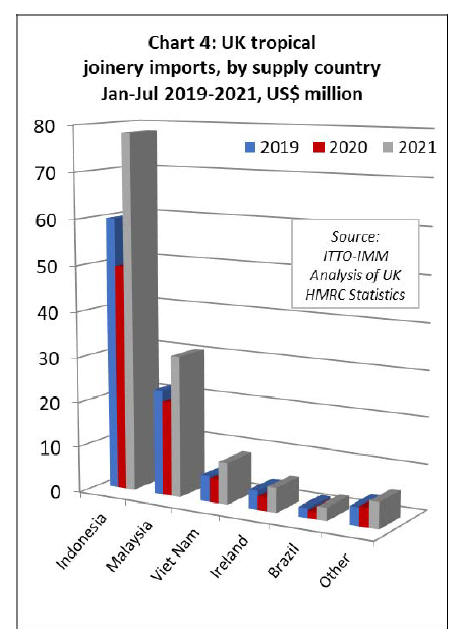
In contrast to joinery products, UK imports of tropical
hardwood plywood have remained at relatively low levels
this year. In the first seven months of 2021, the UK
imported 172,400 cu.m of tropical hardwood plywood,
which is 20% more than the same period in 2020 but still
down 26% compared to the same period in 2019.
Imports from the UK¡¯s three largest suppliers of tropical
hardwood plywood ¨C China, Indonesia and Malaysia ¨C
have followed very different trajectories this year (Chart
5). The UK imported 66,700 cu.m of tropical hardwood
faced plywood from China in the first seven months of this
year, 15% more than the same period in 2020 but down
over 50% compared to the same period in 2019.
In contrast, Malaysian plywood has made gains in the UK
market this year, imports of 41,100 cu.m in the first seven
months being 11% more than the same period in 2020 and
30% up on the same period in 2020. But it should be said
these gains are being made against historically very low
levels after a long period of decline in UK imports of
Malaysia plywood in the years before 2019.
So far this year, UK imports of plywood from Indonesia
have rebounded from the lows of 2020 but are still below
the relatively modest levels of 2019. Imports of 33,600
cu.m in the first seven months of this year are 48% more
than the same period in 2020 but 4% less than in 2019.
As with other hardwood product groups, UK demand for
tropical hardwood plywood has been strong this year,
driven by high levels of construction activity and
shortages of competing materials. The main market
challenges have been on the supply side, notably the
considerable escalation in freight rates on Asian routes to
the UK.
A 40ft container from Malaysia or Indonesia as late as last
autumn cost US$1,500 -2,000. By Q2 2021 importers were
being quoted US$15,000-20,000 and rates have stayed
there.

After falling sharply in May and June last year, UK
imports of tropical sawnwood have gradually
strengthened, but the strength of the rebound has been
impaired by significant logistical problems on the supply
side. UK imports were 46,700 cu.m in the first seven
months of 2021, just 3% more than the same period in
2020 and 26% less than the same period in 2019.
Although imports from Cameroon, now by far the leading
supplier of tropical sawnwood to the UK, were up 66% on
2020 and 43% on 2019 during the seven month period,
imports from nearly all other leading tropical sawnwood
supply countries have remained weak this year (Chart 6).
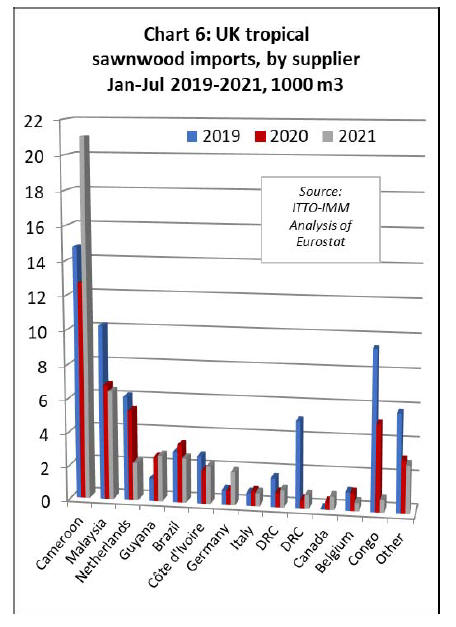
The large increase in imports of sawnwood from
Cameroon was due to the long lead time in shipment of
contracts placed back in 2020. UK importers now report
that supply for hardwoods from Cameroon and other
African supply countries is very limited.
Global demand for species such as sapele, sipo and iroko,
accompanied by production delays and logistical
difficulties, have been such that many African mills placed
a moratorium on taking new orders in late March and
throughout April this year.
UK imports of tropical sawnwood from Côte d'Ivoire were
just 2200 cu.m in the first seven months of this year, 13%
more than the same period in 2020 but still down 20% on
the same period in 2019.
The UK was previously a significant buyer of framire
from Côte d'Ivoire but UK importers report that this
species is proving increasingly difficult to source, both due
to a lack of raw material in the forest and the challenges of
obtaining assurances of legality that satisfy UK Timber
Regulation requirements.
Meanwhile, UK imports of tropical sawnwood from both
the Republic of Congo and DRC have fallen to a trickle
since the start of the pandemic.
Imports from the Republic of Congo were just 700 cu.m
in the first seven months of the year, down 86% and 92%
compared to the same period in 2020 and 2019
respectively. Imports from DRC were 800 cu.m, which is
62% more than the negligible amount imported last year,
but 84% less than the same period in 2019.
After an extremely slow start to the year, brought on by
pandemic induced production problems and extreme
shortages of containers, UK imports of tropical sawnwood
from Malaysia picked up a little in the second quarter with
the arrival in May of the first breakbulk shipments of
Asian meranti and keruing lumber into the UK for nearly
30 years.
UK imports of Malaysian sawnwood were 6,400 cu.m in
the first seven months of 2021. That is still 6% less than
the same period last year and 37% down on the same
period in 2019.
With shortages in supply from other sources, UK
importers were turning more to South America in the
opening months of this year. Imports from Brazil were
quite good in the first quarter but ground to a halt in the
second quarter. By the end of the first seven months, total
UK imports of tropical sawnwood from Brazil were 2,600
cu.m, 23% less than the same period last year and 13%
down on 2020.
Imports from Guyana on the other hand have continued to
rise, at 2,700 cu.m in the first seven months this year, a
gain of 4% on the same period in 2020 and double the
volume imported in the same period in 2019.
Indirect UK imports of tropical sawnwood from other EU
countries have fallen dramatically this year. Total UK
imports from EU countries were 6,900 cu.m in the first
seven months of 2021, 25% less than the same period last
year and 46% down on the same period in 2019.
The UK imported 5,200 tonnes of tropical hardwood
mouldings/decking in the first seven months of 2021, 31%
more than the same period in 2020 but still 33% less than
the same period in 2019. The arrival of the first breakbulk
shipments into the UK this year boosted imports a little
from Indonesia, which at 1,800 tonnes in the first seven
months were 6% more than the same period in 2020, but
still down 60% compared to 2019.
Similarly, imports from Malaysia, at 1,400 tonnes, were
21% more than the same period in 2020 but 29% less than
in 2019. Imports from Brazil have also picked up a little,
at 1,100 tonnes in the first seven months, 49% more than
the same period last year 1% more than in 2019 (Chart 7).
The UK market is currently suffering from severe lack of
availability of tropical hardwood decking, due both to the
freight hikes and also to suppliers preferring to sell the
limited stocks they have available to other markets.
This has forced more UK importers to purchase more
tropical decking from importers in the Netherlands. The
UK imported 400 tonnes of tropical hardwood decking
from the Netherlands in the first seven months of this year
when previously very little was sourced indirectly from
there.
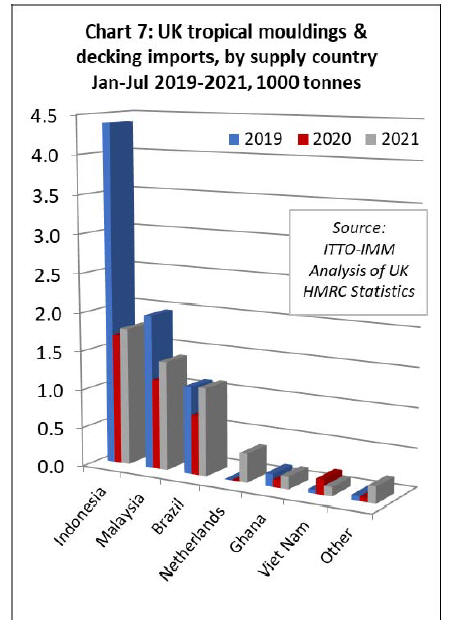
Big increase in UK timber imports from the EU despite
Brexit
An impact of the UK¡¯s departure from the EU single
market and customs union on 1st January this year was
meant to be a decline in the quantity of UK timber imports
from the EU.
This forecast followed expectations of logistical problems
as new controls were introduced at the UK border,
increased scrutiny of the plant health and legal status of
EU wood products imported into the UK, and sluggish
economic activity in the UK due to post Brexit
uncertainty.
However, not only did UK imports from the EU fail to
decline in the first half of 2021, but they were at record
levels. Chart 8 shows the quantity of UK imports of all
wood and wood furniture products from the EU (excluding
wood for fuel) on a monthly basis since the start of 2017.
In total, the UK imported 4.13 million tonnes of wood
products from the EU27 in the first seven months of 2021,
40% more than the previous year, which of course was
COVID-affected, but also 21% more than in 2019, the last
¡°normal¡± year.
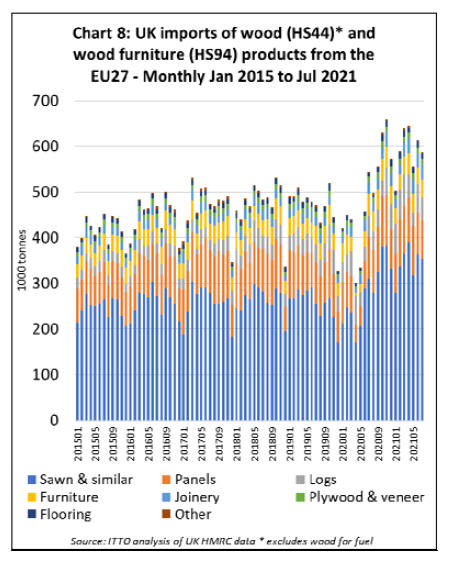
Most of this growth was concentrated in softwood
sawnwood and logs and panel products, which dominate
UK imports from the EU27 (at least in tonnage terms).
However, imports of furniture and hardwood products
which compete more directly with imports from the
tropics also grew strongly from the EU in the opening
months of this year.
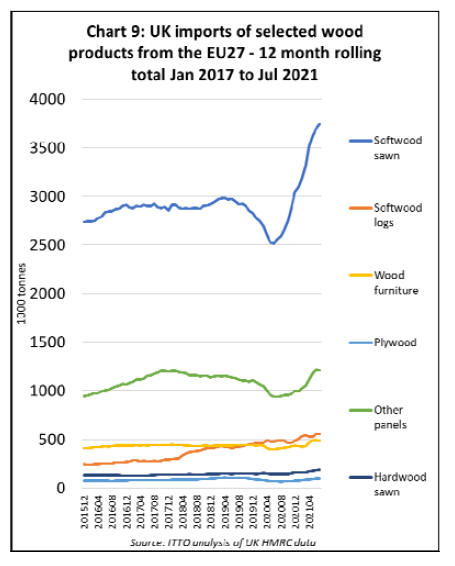
Of course it is early days for the UK outside the EU single
market, and the UK timber market is currently
experiencing unprecedented conditions due to the COVID
pandemic. The combination of very high levels of
consumption in the UK construction and DIY sectors and
severe disruption of supplies from sources further afield -
in China, Southeast Asia, North and South America, and
Africa - has fed a significant upturn in UK demand and
prices for timber imports from the EU.
Importers and distributors have had a strong incentive to
overcome the new logistical and bureaucratic challenges
of sourcing from the EU.
The main question now is whether this situation will be
maintained for the long term, and whether there is any
genuine potential for the UK to pivot away from the EU as
logistical problems ease in other parts of the world.
The market signals are still mixed in relation to this
question. The UK's exit from the EU has contributed to a
significant fall in indirect imports of tropical sawnwood
and plywood from the European continent during 2021.
But this has yet to be compensated by any significant rise
in direct imports of these same products from tropical
countries.
However, the uptick this year in UK imports of wooden
doors from Indonesia and of other joinery products from
Malaysia to levels exceeding those pre-pandemic, despite
very high freight rates, is some grounds for optimism.
|